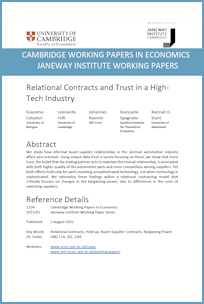
Debnath, R., Bardhan, R., Mohaddes, K., Shah, D. U., Ramage, M. H. and Alvarez, R. M.
People-centric Emission Reduction in Buildings: A Data-driven and Network Topology-based Investigation
JIWP Number: 2201
Abstract: There is a growing consensus among policymakers that we need a human-centric low-carbon transition. There are few studies on how to do it effectively, especially in the context of emissions reduction in the building sector. It is critical to investigate public sentiment and attitudes towards this aspect of climate action, as the building and construction sector accounts for 40% of global carbon emissions. Our methodology involves a multi-method approach, using a data-driven exploration of public sentiment using 256,717 tweets containing #emission and #building between 2009 - 2021. Using graph theory-led metrics, a network topology-based investigation of hashtag co-occurrences was used to extract highly influential hashtags. Our results show that public sentiment is reactive to global climate policy events. Between 2009-2012, #greenbuilding, #emissions were highly influential, shaping the public discourse towards climate action. In 2013-2016, #lowcarbon, #construction and #energyefficiency had high centrality scores, which were replaced by hashtags like #climatetec, #netzero, #climateaction, #circulareconomy, and #masstimber, #climatejustice in 2017-2021. Results suggest that the current building emission reduction context emphasises the social and environmental justice dimensions, which is pivotal to an effective people-centric policymaking.
Keywords: building, computational social science, Emission, people-centric transition, Twitter
JEL Codes: C63 Q54
Author links: Kamiar Mohaddes
PDF: jiwp2201.pdf 
EPRG Paper Link: 2203
Open Access Link: 10.17863/CAM.81919
Keynes Fund Project(s):
Energy Incentives and Market Mechanism in Slum Rehabilitation Housing for Distributive Justice (JHVH)
